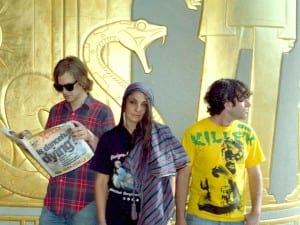Exploring the connection between human emotion and the possibility of divine intervention, contemporary fantasy Angels of Destruction considers the ability of art and imagination to create new worlds.
Angels of Destruction is the second novel from Keith Donohue, cementing the success of his best-selling debut The Stolen Child. Released to great critical acclaim, The Stolen Child re-works the ancient legend of the changeling; the child kidnapped into the magical land of Faery and replaced with an otherworldly, soulless impostor. Angels of Destruction treads a similar path between the real and the unreal, with the inexplicable, midnight appearance of magical child Norah, and the sinister man in the fedora that follows her. Lyrical, evocative prose and authorial ambiguity blur the boundaries between the fantastical and the everyday. “To paraphrase Nabokov, all novels are essentially fairytales. Novels ask us to believe in their intrinsic logic and reality. It seems an equal leap to accept a story of, say, Chesil Beach, as to believe – at least temporarily – in ghosts or dragons or angels,” says Donohue.
To categorise Donohue’s work as fantasy is misleading, because the label can be vulnerable to negative, less prestigious connotations. As Donohue notes: “There are many people around the world who simply dismiss any novel that isn’t, at least superficially, realistic.” Perhaps more fitting is to situate Donohue’s work within the genre of Magical Realism. Used extensively in literature, art and film, Magical Realism was first applied to South American Literature, but has become widespread amongst English Language writers. One of the first to use the idiom was Alejo Carpentier, in the prologue to 1949 novel The Kingdom of this World; Carpentier used “lo real maravilloso” (marvellous reality), as he explained it “elements of the miraculous could appear while seeming natural and unforced.”
Donohue seamlessly integrates magical elements into otherwise realistic scenarios; for example, the mystifying appearance of Norah at Margaret Quinn’s door is given credibility by Margaret’s own neglect to question the possible supernatural visitation. Norah: “I have been looking for some place, and your light was on, and there is a welcome mat at your door. You were expecting someone.” Margaret: “No one ever comes”, “I am here”, “That you are.” Offset with descriptions of the natural – the cold winter’s night and Norah’s physicality – this promotes acceptance of magic as the norm. A major preoccupation of Donohue is to “re-enchant contemporary life, bring some magic to the quotidian, some unexpected grace note. The use of angels, changelings or other kinds of magic is another path to the underlying – and very real – human concerns and emotions.” The Stolen Child was not about the magical changeling, but rather the condition of the human child. Similarly, as Donohue says of Angels of Destruction: “It isn’t a story about angels, but a story about loneliness in which angels are brought forth by the situation.”
Margaret Quinn grieves for missing daughter Erica, who ran away from home with teenage sweetheart Wiley to join the hard-line activist cult “Angels of Destruction.” After Erica left, Margaret was unable to find comfort even with husband Peter, who later died. Receiving only two hastily written postcards in the ensuing 10 years, Margaret retreated into a self-constructed world of misery, spending the years fervently hoping and praying for Erica’s return. This is the point her night caller wakes her. Is Norah human or divine? Eagerly grasping at the comfort she intuits in the child, Margaret decides to pass Nora off as her fictitious granddaughter: “Her daughter had been gone for a decade, and the girl appeared to be just shy of nine. Old enough to be her own granddaughter, had such a child ever existed.” Conspiring to keep up the pretence that Norah the mysterious orphan is really Norah Quinn, granddaughter, propels the plot. Norah and Margaret, becoming invaluable co-conspirators, befriend the boy next door, Sean Fallon, as the trio strives to keep up the facade for friends, family and the authorities.
As significant inspirations behind Angels of Destruction, Donohue cites Paul Klee’s abstract angel paintings and Wallace Stevens’ poems The Snow Man and Angel Surrounded by Paysans. Introducing Angels of Destruction is a quotation from American poet, Emily Dickinson: “Hope is the thing with feathers that perches in the soul.” Fascinated with death and immortality, for Dickinson the spirit and mind were tangible places – entities one could almost visit. The quote Donohue has chosen captures the dichotomy of hope as a human feeling, which is given physical embodiment as a divine article. If such a manifestation can arise from the strength of human feeling, perhaps the force of Margaret’s ardent prayer summoned the child? “I am curious about how people believe in things unseen and have reservoirs of faith in the darkest hours,” explains Donohue, “Margaret has a kind of faith that she may one day find some solace or redemption from her grief.” Margaret interprets the arrival of Norah as a second chance at motherhood, as compensation for her lost family: “Perhaps this was God’s way, she thought, of answering her constant prayer. Some company, some restitution for all that had been taken from her.”
It is, however, important not to read Angels of Destruction as a religious parable. For understanding fairytales, a useful text is Marcia Lane’s Picturing a Rose: A way of looking at Fairy Tales; Lane observes that “Fairytales are sometimes spiritual, but never religious.”
Faith is supreme, yet Donohue clarifies “Angels of Destruction is deliberately open-ended on the question of religion and, in fact, contains elements of many traditions.” Expanding further, he states: “More importantly, the book looks at the question of spirituality and belief through its many characters.” For example, by taking a shortcut home from school, Sean Fallon crosses Margaret’s land. Ill-at-ease trespassing in this way: “Each time he crossed the boundary, he recited, ‘Forgive us our trespasses, as we forgive those who trespass against us,’ not entirely sure what the words meant, which only reinforced their magic.” Sean takes the rhetoric of the Christian prayer and confuses the meaning of the words; however, it is Sean’s emotional conviction in the incantation as a protective talisman that invests the prayer with its worldly power.
An important character in the novel, Sean is Norah’s aide in all her endeavours – from fitting in at school to the ultimate goal of locating Erica Quinn and reuniting her with Margaret. “One of the fun parts of writing this story was creating the separate worlds of the children and those of the adults.” At school, Norah gradually discloses her secrets to Sean and the other children, who rapidly come to adore her. “They fell in love with her. Each day illuminated some new aspect of her character that caused the children of Friendship School third-grade class to wonder what strange creature had landed in their midst. Ordinary miracles abounded. A pop quiz produced the unexpected result of perfect scores all round. There were no acts of violence, no bullying of the meek; a kind of harmony descended.” From tricks such as smoke rings and inexplicably real drawings to suspending time and controlling the weather, the children wholeheartedly believe Norah when she reveals herself to be an angel. It is only the adults who strive to rationalise, whether logical or not and eventually deem Norah mentally disturbed.
Norah’s artistic skill is a blessing she shares with Erica, as if they were true mother and daughter, which they compulsively use to interpret and brighten the world around them. “Erica and Norah are both visual artists, and that is part of the whole plan of re-enchantment that drives the novel,” Donohue divulges: “They are creating new worlds out of their imaginations. The key paintings are Erica’s versions of Nagasaki angels, taking from her father’s mysterious past and recreating something luminous.” Whether secular or spiritual, Norah is the catalyst for this destruction and creation.
Supernatural abilities aside, a further indubitable quality Norah possesses is a child’s openness, which she uses to confront the silence that paralyses the adults. Her directness has the power to force Margaret from her emotional stasis: “She was used to moving numbly through the desolation of her life. Like the survivors of momentous devastation, she had patched her sorrow and moved on to some semblance of normalcy. And now the girl had come, and Margaret sensed the cracks in her will to abide nothing but the memory of her daughter. Everything, bad as it was, had been fine, bearable. But this morning, Norah had shattered the world.”
Published by Jonathan Cape, Angels of Destruction is available now.
Samantha Cracknell




